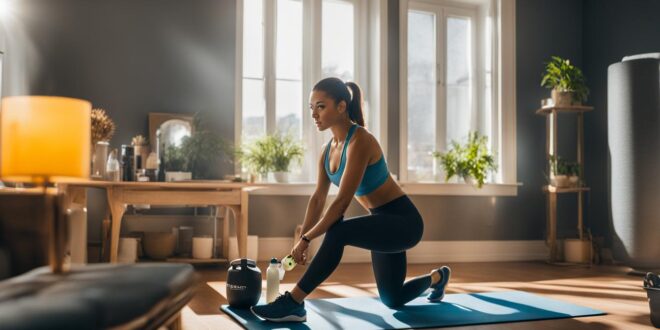Maintaining health and fitness can be a challenge for busy individuals with hectic schedules. However, creating a sustainable workout routine is crucial for overall well-being. With the right strategies in place, you can prioritize your fitness goals and achieve them from the comfort of your own home.
Starting a fitness routine at home is a convenient option for beginners. It allows you to exercise at your own pace, without the pressure of a gym or fitness class. Whether you have limited time or prefer the privacy of your home, there are plenty of effective workouts that can help you stay fit and healthy.
Key Takeaways:
- Creating a sustainable fitness routine at home is crucial for busy individuals
- Prioritize your fitness goals and schedule exercise into your daily routine
- Start small and progress gradually to prevent injury and burnout
- Find a workout partner to make exercise more enjoyable and accountable
- Make exercise convenient by choosing a gym or investing in basic fitness equipment
Prioritize Fitness and Schedule Exercise
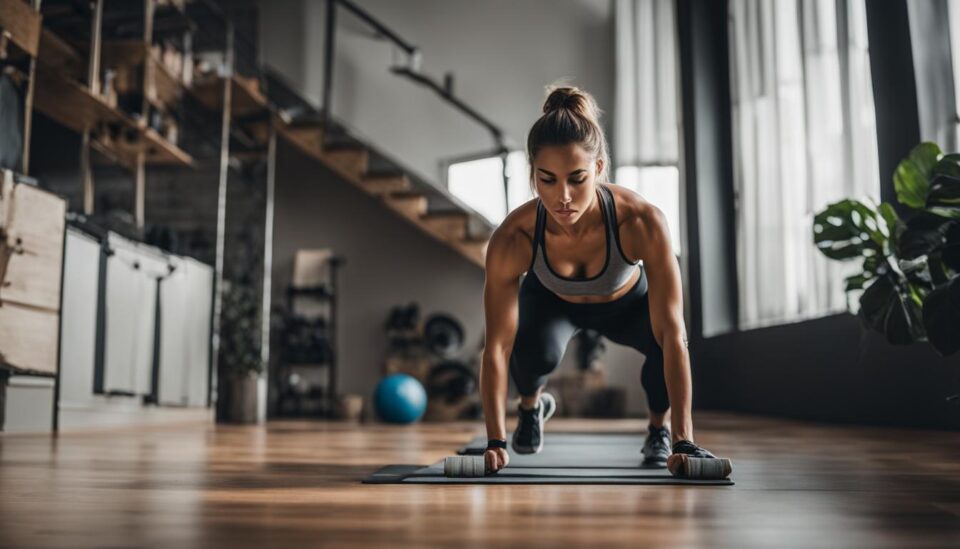
To build a sustainable fitness routine, it’s important to prioritize fitness and schedule exercise into your daily routine. Treating exercise as non-negotiable appointments and committing to regular workouts each week can help you achieve your fitness goals effectively.
Make fitness a priority: In order to make progress and see results, it’s crucial to prioritize fitness in your life. Recognize the importance of exercise for your overall well-being and make it a non-negotiable part of your daily routine.
Schedule your workouts: Treat your exercise sessions as appointments that cannot be missed. Plan your workouts in advance and choose specific days and times that work best for you. By dedicating specific time slots to exercise, you are more likely to follow through and make fitness a habit.
Start small and gradually increase: If you’re a beginner, it’s important not to overwhelm yourself with intense workouts right from the start. Start with simple exercises or activities that you enjoy and gradually increase the intensity and duration as your fitness level improves. This approach helps prevent burnout and injuries, while allowing your body to adapt to the new routine.
Utilize available resources: Working out at home is convenient and cost-effective. You can find numerous online fitness programs, workout videos, and mobile apps that cater to beginners. These resources provide guidance and structure for your fitness routine, making it easier to stay consistent and motivated.
Remember, consistency is key when it comes to fitness. By prioritizing fitness and scheduling exercise into your daily routine, you are taking an important step towards achieving your health and fitness goals. So make the commitment, start small, and watch as your fitness routine becomes a permanent part of your lifestyle.
Start Small and Progress Gradually
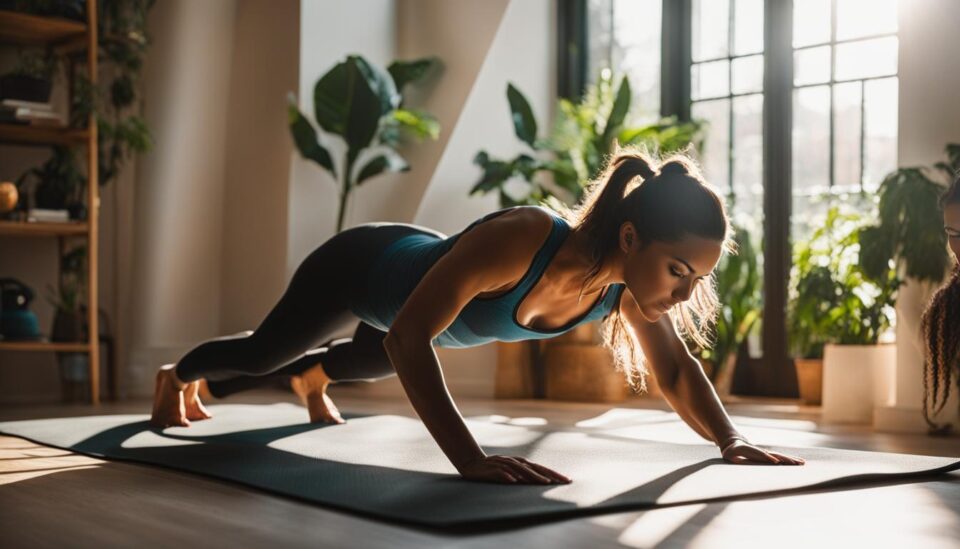
Whether you’re new to exercise or have a busy schedule, starting small and progressing gradually is key to building a sustainable fitness routine. This approach allows you to build a solid foundation and prevent injury and burnout. It’s especially important for individuals who want to engage in fitness routines without equipment.
Begin by setting small, attainable goals that align with your current fitness level and available time. For example, you could start with daily walks or short bodyweight workouts at home. By starting small, you’ll be able to establish a consistent exercise habit and gain confidence in your abilities.
Progressing gradually is essential to avoid pushing yourself too hard and risking injury. As you become more comfortable and fit, gradually increase the intensity, duration, or complexity of your workouts. This gradual progression allows your body to adapt and prevents plateaus in your fitness journey.
Remember, fitness is a journey, not a race. Embrace the process and celebrate each milestone you achieve along the way. As you continue to start small and progress gradually, you’ll be amazed at how far you can go in improving your fitness and overall well-being.
Find a Workout Partner for Accountability
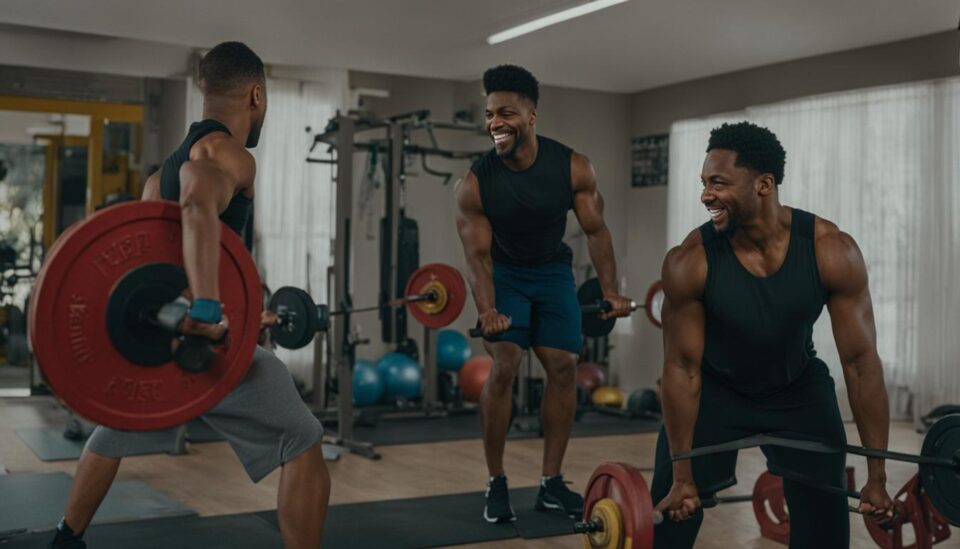
Exercising alone can sometimes feel monotonous and lack motivation. That’s where finding a workout partner can make a significant difference. Collaborating with a friend or family member can not only make workouts more enjoyable but also provide the accountability needed to stay consistent with your exercise routine.
A workout partner can serve as a source of motivation, pushing you to give your best during each session. Having someone by your side cheering you on can help you push through challenging workouts and reach new fitness goals.
Whether you’re looking for fitness routines for men at home or fitness routines for women at home, finding a workout partner can benefit individuals of all genders. It creates an opportunity to foster relationships centered around shared fitness goals, resulting in a support system that keeps you accountable.
When choosing a workout partner, consider someone who shares similar fitness goals and schedules. Look for individuals with a positive attitude and a commitment to their own health and wellness. This way, you can motivate each other to stay on track and achieve your desired results.
Benefits of Finding a Workout Partner:
- Increased motivation and support
- Enhanced accountability
- Opportunity to challenge and push each other
- Improved consistency in sticking to exercise routines
- Enjoyable and social workout sessions
To find a compatible workout partner, consider joining fitness classes, local sports clubs, or online fitness communities. Additionally, reach out to friends, colleagues, or family members who have expressed an interest in improving their fitness. Collaborating with a workout partner not only makes exercise more fun but also increases the likelihood of achieving your fitness goals.
Make Exercise Convenient
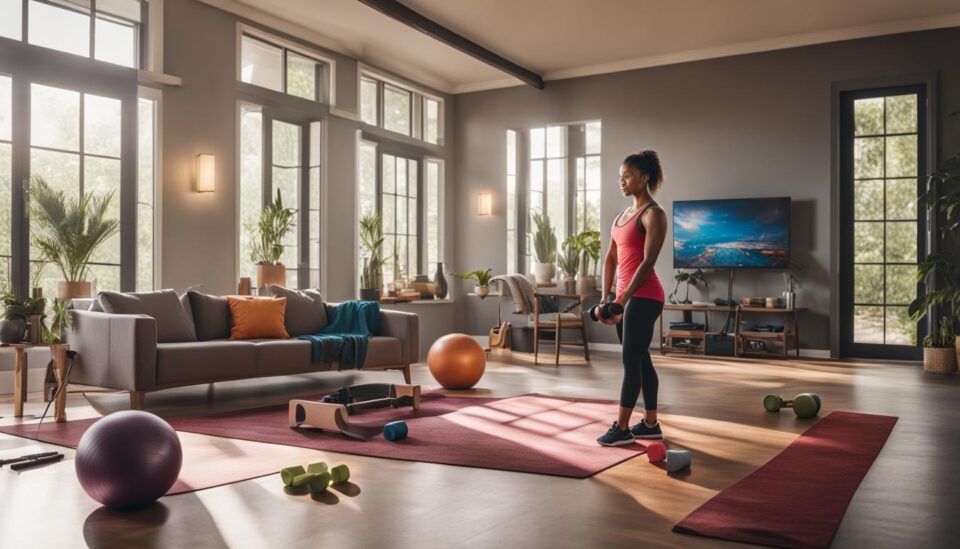
Consistency is key when it comes to maintaining a fitness routine at home. One of the most effective ways to ensure regular exercise is by making it convenient and easily accessible.
Here are some strategies to help you make exercise a convenient part of your daily life:
- Choose a gym or fitness facility near your home or workplace. Having a location that is close by eliminates the need for long commutes and makes it easier to fit exercise into your busy schedule.
- If going to a gym is not feasible, consider creating a fitness space at home. Invest in basic equipment like resistance bands or dumbbells that can provide a variety of workout options without taking up too much space.
- Set up a dedicated workout area in your home. Whether it’s a corner in your living room or a spare room, having a designated space for exercise can help you stay focused and motivated.
- Make use of online fitness resources. There are numerous fitness apps and websites that offer guided workouts and exercise routines that can be done from the comfort of your own home.
By making exercise convenient and removing barriers to regular physical activity, you’ll be more likely to stick to your fitness routine and achieve your health and wellness goals.
Change Things Up to Stay Motivated

Repeating the same exercise routine can lead to boredom and demotivation. To stay engaged and motivated in your fitness routine for beginners at home or fitness routines for men at home, it’s important to change things up and add variety to your workouts.
Incorporating different exercises not only works different muscle groups but also keeps your workouts interesting. You can try incorporating bodyweight exercises like push-ups, squats, and lunges, or use resistance bands for added intensity.
Varying your cardio regimen is also crucial. Instead of sticking to one form of cardio, such as running or cycling, try different activities like swimming, dancing, or jump rope. This not only challenges your cardiovascular system but also prevents monotony and provides a fresh and enjoyable workout experience.
If you prefer a structured approach, considering trying out new fitness classes either in-person or online. Whether it’s yoga, Zumba, kickboxing, or pilates, trying different classes can expose you to new exercises, techniques, and training methods.
Remember, the key to maintaining interest and progress towards your fitness goals is to keep your workouts fresh, challenging, and enjoyable. Don’t be afraid to experiment, try new exercises, and switch things up regularly.
Here are some ways to change things up in your fitness routine at home:
- Try new exercises or variations of familiar ones
- Switch between different forms of cardio
- Join fitness classes or try online workouts
- Experiment with different training methods, such as high-intensity interval training (HIIT) or circuit training
- Challenge yourself with new goals and targets
Set Realistic and Achievable Goals

When embarking on a fitness journey, it’s important to set realistic and achievable goals. Whether you’re aiming for weight loss, muscle gain, or improved performance, breaking down your goals into smaller, more manageable objectives can make them less overwhelming and more attainable.
By setting realistic goals, you’re setting yourself up for success. Unrealistic expectations can lead to frustration and disappointment, which can ultimately derail your progress. Instead, focus on setting goals that are challenging but within reach.
- Start by evaluating your current fitness level and capabilities. This will help you gauge what is realistic for your unique circumstances.
- Consider your lifestyle and time constraints. Set goals that are aligned with your daily routine and schedule. This will make it easier to integrate fitness into your life.
- Be specific with your goals. Instead of saying “lose weight,” aim for a specific amount of weight loss in a given timeframe.
- Break down your larger goals into smaller milestones. Celebrate each milestone achieved, as this will keep you motivated and encouraged along the way.
Remember, progress is not always linear. There may be setbacks and challenges along the way, but by setting realistic goals, you’ll be better equipped to handle them and stay committed to your fitness routine.
“Setting goals is the first step in turning the invisible into the visible.” – Tony Robbins
Celebrate your successes, no matter how small. When you accomplish a milestone or reach a goal, take the time to recognize and celebrate your achievements. This positive reinforcement not only boosts your motivation but also reinforces your commitment to your fitness journey.
Setting realistic and achievable goals is crucial for maintaining long-term motivation and progress. So, take the time to assess your capabilities, be specific in your objectives, break them down into manageable steps, and celebrate your successes along the way. With this approach, you’re more likely to stay dedicated, see results, and enjoy the process of achieving your fitness goals.
Celebrate Progress and Achievements

Every small step towards your fitness goals should be celebrated. It’s important to keep track of your progress, record your workouts, and acknowledge your achievements along the way. Recognizing your hard work and success can provide the motivation and encouragement to continue your fitness journey.
Whether you’re a beginner or an experienced fitness enthusiast, it’s essential to celebrate the milestones you reach. Take the time to reflect on how far you’ve come and give yourself credit for your dedication and effort. By celebrating your progress, you reinforce positive habits and maintain a positive mindset.
One way to track your progress is by keeping a workout journal or using fitness tracking apps. These tools allow you to record your workouts, monitor your performance, and set new goals. They provide a tangible record of your achievements and serve as a visual reminder of your progress.
“Success is not final, failure is not fatal: It is the courage to continue that counts.” – Winston Churchill
Celebrating progress is not just about reaching major milestones; it’s about appreciating the smaller victories too. For example, if you were able to complete an extra rep, increase your weights, or run a faster mile, take a moment to acknowledge and celebrate these achievements.
The path to fitness is not always smooth, and there may be setbacks along the way. When faced with challenges, it’s important not to dwell on the setbacks but to focus on the progress you’ve already made. Use setbacks as opportunities to learn and grow, and remember that every journey has its ups and downs.
By celebrating your progress and achievements, you foster a positive relationship with fitness. It becomes more than just a means to an end; it becomes a source of joy, fulfillment, and personal growth. So, take the time to celebrate your hard work and embrace the journey towards your fitness goals.
Remember:
- Celebrate every milestone, no matter how small
- Keep track of your progress using workout journals or fitness tracking apps
- Appreciate the smaller victories and acknowledge your hard work
- View setbacks as opportunities for growth
- Embrace the journey and the positive impact fitness has on your life
Understand Time Constraints and Prioritize Goals
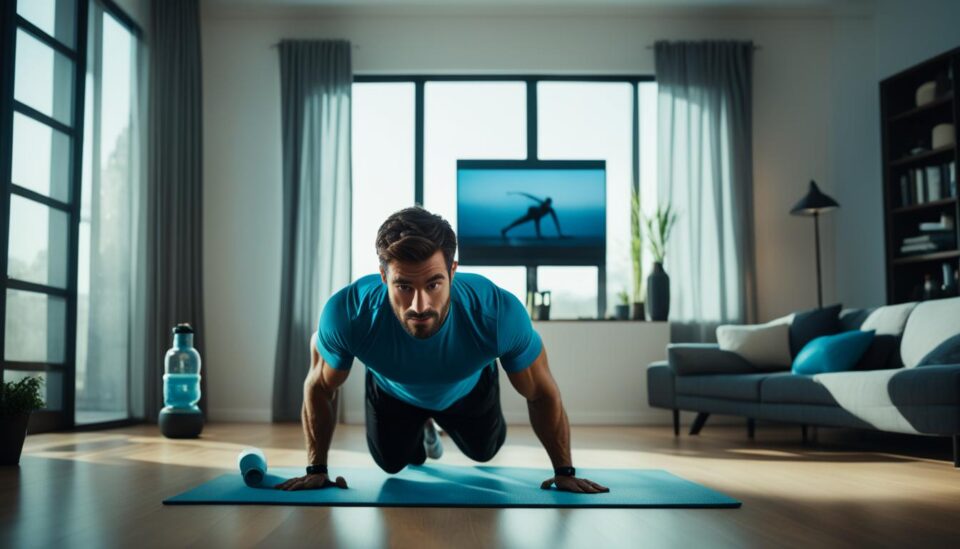
As a personal trainer, it’s crucial to understand the time constraints of your clients and prioritize their fitness goals. Every individual has a unique schedule and set of responsibilities, so it’s important to have open and honest discussions about their daily routines. By gaining insight into their time limitations and commitments, you can create a tailored workout plan that fits seamlessly into their busy lives.
We live in a fast-paced world where time is a precious commodity. Many people find it challenging to carve out dedicated time for exercise amidst work, family, and personal obligations. This is where your expertise as a personal trainer comes into play. By taking the time to understand your clients’ time constraints, you can help them develop a fitness routine that is both effective and sustainable.
During your discussions, ask your clients about their typical daily schedule, including work hours, family commitments, and other responsibilities. This will give you a clearer picture of the windows of time they have available for exercise. Encourage them to be specific about the days and times when they feel most motivated and energized to work out.
By understanding your clients’ time constraints, you can determine the ideal frequency and duration of their workouts. For individuals with busy schedules, shorter, more frequent workouts may be more realistic and achievable. This could mean incorporating quick, high-intensity interval training (HIIT) sessions or circuit training into their fitness routine. These types of workouts can deliver maximum results in a shorter amount of time.
It’s also important to prioritize your clients’ fitness goals based on their time constraints. Take the time to discuss what they hope to achieve through their fitness journey. Whether it’s weight loss, muscle toning, or improving overall health, understanding their goals will enable you to tailor their workout plan accordingly. This personalized approach will give your clients the motivation and focus they need to stay committed to their fitness routine.
Creating a Realistic Schedule
Once you have a clear understanding of your clients’ time constraints and goals, it’s time to create a realistic schedule that accommodates their needs. Consider the following tips:
- Break down their workout sessions into smaller, more manageable increments. This will make it easier to fit exercise into their daily routine without feeling overwhelmed.
- Encourage them to schedule their workouts like any other important appointment. By treating exercise as a non-negotiable commitment, they are more likely to prioritize it and stick to their schedule.
- Explore home workout options that require minimal equipment. This will allow your clients to exercise conveniently without the need for a gym or specialized equipment. A fitness routine at home without equipment can be just as effective.
- Offer flexibility in their workout plan. Life can be unpredictable, and there may be days when your clients simply cannot fit in a full workout. Encourage them to incorporate short bursts of activity throughout the day, such as taking the stairs instead of the elevator or going for a brisk walk during their lunch break.
Understanding your clients’ time constraints and prioritizing their goals will not only help them achieve their desired fitness outcomes but also foster a sense of trust and collaboration. Your clients will appreciate your ability to work within their busy schedules while still delivering effective and results-driven workouts.
Balance Exercise Frequency, Intensity, and Duration
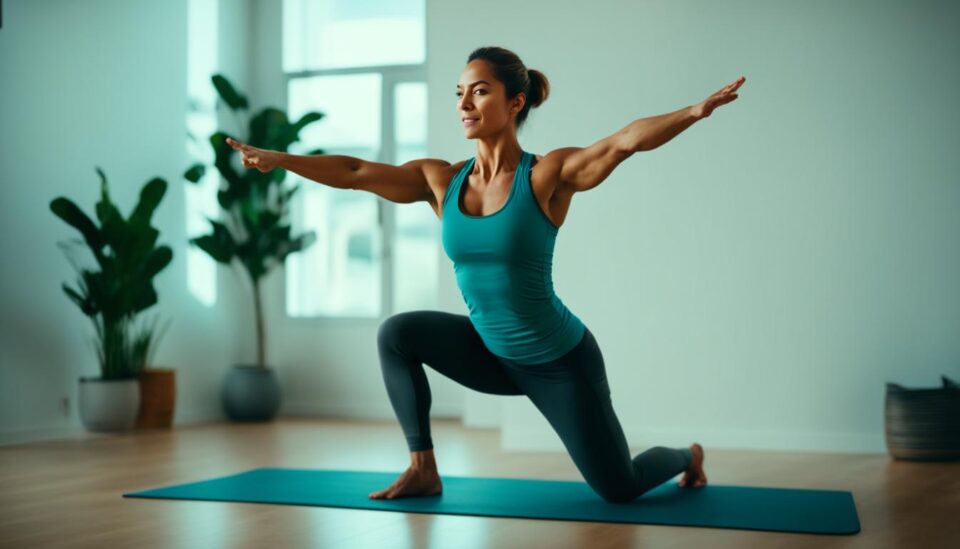
When it comes to creating workout plans for busy individuals, finding the right balance between exercise frequency, intensity, and duration is crucial. By adjusting these factors based on your client’s available time, you can ensure they still achieve their fitness goals effectively.
Avoiding an all-or-nothing approach is key. Encourage your clients to incorporate short bursts of exercise throughout their day, even if they can’t commit to a traditional hour-long workout. Suggest taking the stairs instead of the elevator, going for quick walks during lunch breaks, or doing a few minutes of high-intensity exercises at home.
By finding creative ways to incorporate exercise into their daily routine, your clients can increase their exercise frequency without sacrificing too much time from their busy schedules.
When it comes to intensity, remind your clients that it’s okay to start small and gradually increase the intensity of their workouts. This approach not only prevents burnout and injury but also helps build a solid foundation for long-term success.
Additionally, emphasize the importance of finding exercises that can be done without equipment. Fitness without equipment is convenient and eliminates the need for expensive gym memberships or bulky home workout machines.
Remind your clients that there are plenty of effective bodyweight exercises that can be done at home, such as push-ups, squats, lunges, and planks. These exercises engage multiple muscle groups and can be easily modified to match different fitness levels.
Ultimately, achieving a balance between exercise frequency, intensity, and duration is the key to maintaining a sustainable fitness routine for busy individuals. By customizing workout plans that fit their available time and preferences, you can help them reach their goals while still juggling their daily responsibilities.
Key Points:
- Adjust exercise frequency, intensity, and duration based on available time.
- Incorporate short bursts of exercise throughout the day.
- Start small and gradually increase intensity.
- Emphasize fitness without equipment using bodyweight exercises.
- Customize workout plans to fit busy schedules and preferences.
Set Realistic Expectations Based on Time Constraints
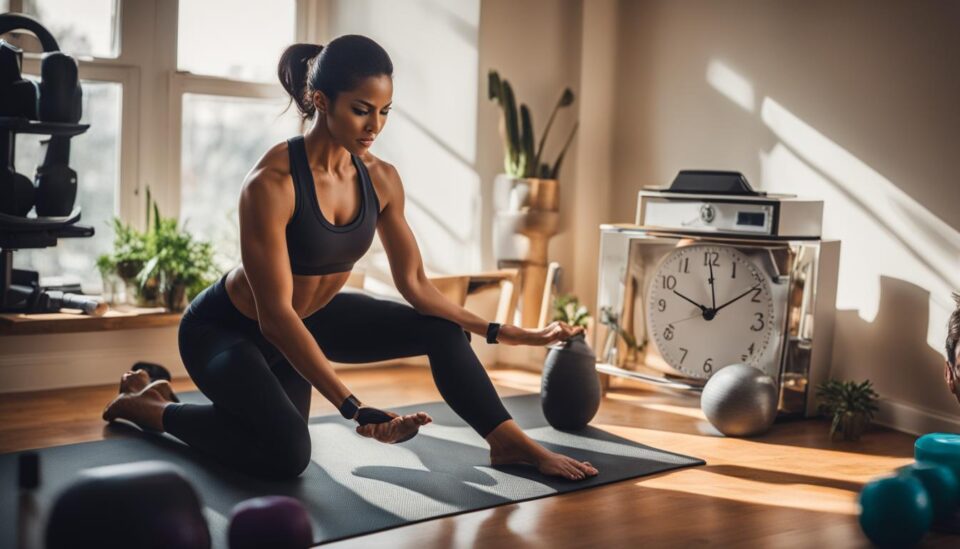
When it comes to maintaining health at home, setting realistic expectations is key. As a fitness professional, your role is to help clients understand the importance of balancing their fitness goals with their available time. Encourage them to embrace consistency and gradual progress, reminding them that even small increments of exercise can contribute to their overall well-being.
Optimizing the limited time they have for fitness is crucial, and it starts with managing expectations. By setting realistic goals based on their time constraints, clients can avoid frustration and maintain a positive mindset throughout their fitness journey.
Consistency is the foundation for success. Encourage your clients to commit to regular workouts, even if they are short. Remind them that a 10-minute workout today is better than skipping altogether. It’s the consistency that matters in the long run.
Gradual progress is a key component of maintaining health at home within busy schedules. Remind your clients that it’s not about achieving overnight transformations but rather making small improvements over time. Each workout builds upon the previous one, leading to long-term results.
Remember to emphasize the importance of a balanced approach. Prioritizing self-care and mental well-being is just as important as physical fitness. Encourage your clients to find a routine that works for them and fits realistically into their daily lives.
By helping your clients set realistic expectations and guiding them on a consistent and gradual fitness journey, you can empower them to achieve their health and wellness goals, even with limited time.
High-Intensity Interval Training (HIIT)
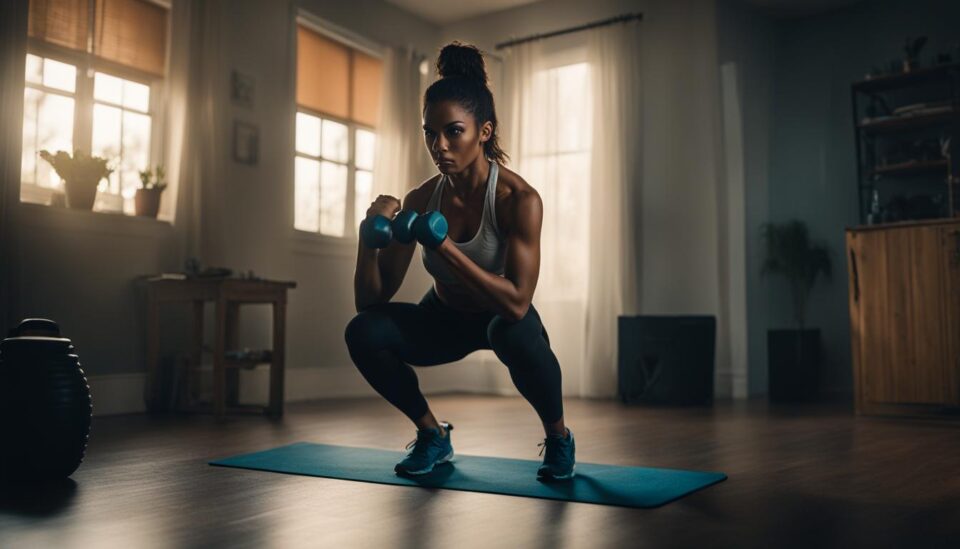
High-Intensity Interval Training (HIIT) is a highly effective fitness routine for beginners at home who are short on time. This workout method involves alternating between short intense bursts of activity and short rest periods. HIIT workouts can be completed in as little as 10 to 30 minutes, making them perfect for busy individuals.
During a HIIT workout, you push your body to its maximum capacity during the intense intervals, followed by brief recovery periods. This type of training boosts calorie burn, improves cardiovascular health, and increases metabolism. Moreover, HIIT workouts continue to burn calories even after the session ends, thanks to the “afterburn effect.”
One of the great things about HIIT is its versatility. You can incorporate various exercises into your routine, such as sprinting, bodyweight exercises, or using fitness equipment like kettlebells or dumbbells. Remember, the intensity is the key, so be sure to challenge yourself during the intense intervals.
Incorporating HIIT into your fitness routine can help you maximize your workout time while reaping numerous health benefits. It is worthy to note that if you have any underlying health conditions or concerns, it’s always a good idea to consult with a healthcare professional before starting any new exercise program.
Don’t let time constraints hold you back from achieving your fitness goals. Try incorporating high-intensity interval training (HIIT) into your fitness routine and experience the benefits of this time-efficient workout.
Circuit Training

Circuit training is a highly effective fitness routine for men at home that involves performing a series of exercises with minimal rest in between. This time-efficient workout method keeps your muscles continuously engaged and your heart rate elevated, helping you burn calories and build strength.
One of the great things about circuit training is its versatility. You can incorporate a variety of bodyweight exercises such as push-ups, squats, lunges, and planks to target different muscle groups. To amp up the intensity, you can also use weights or resistance bands for added resistance.
Circuit training not only helps you build strength and endurance but also improves your cardiovascular fitness. By alternating between different exercises, you engage multiple muscle groups and challenge your body in different ways, resulting in a comprehensive full-body workout.
With circuit training, you can design your own workout routine according to your fitness level and goals. You can choose the number of exercises, the duration of each exercise, and the rest periods in between. This flexibility allows you to tailor your workout to your specific needs.
Remember to warm up properly before starting a circuit training session and cool down afterwards to prevent injury and aid recovery. Make sure to maintain proper form and technique throughout each exercise to maximize effectiveness and minimize the risk of injury.
Incorporating circuit training into your fitness routine is a fantastic way to challenge yourself, stay motivated, and see results. Whether you’re a beginner or an experienced fitness enthusiast, circuit training provides a dynamic and efficient workout that can be done in the comfort of your own home.
Tabata Training
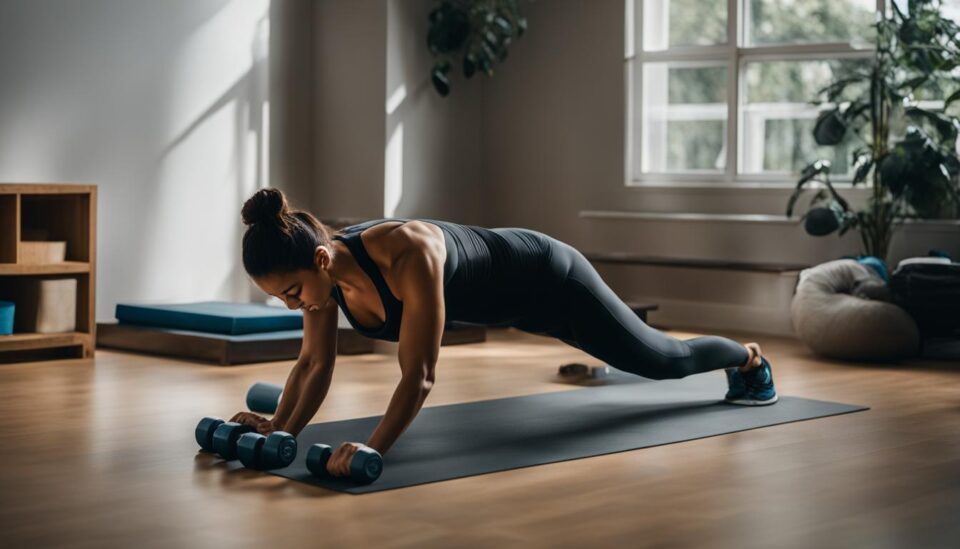
Tabata training is a highly effective form of high-intensity interval training (HIIT) that can be easily incorporated into fitness routines at home. This training method involves short, intense intervals of exercise followed by brief rest periods, providing a challenging workout in as little as four minutes. Tabata training is ideal for busy individuals looking to maximize their workout time and achieve significant results.
During a Tabata session, you perform an exercise at maximum effort for 20 seconds, followed by a 10-second rest period. This cycle is repeated for a total of eight rounds, resulting in a total workout time of just four minutes. The key to Tabata training is to push yourself to the limit during each interval, making it a highly efficient and time-effective way to improve cardiovascular fitness, burn calories, and increase muscle endurance.
Tabata training can be tailored to individual fitness levels and goals by selecting exercises that target specific muscle groups or incorporate a variety of movements. Popular Tabata exercises include squats, burpees, push-ups, mountain climbers, and jumping lunges. By choosing exercises that engage multiple muscle groups, you can effectively work your entire body in a short amount of time.
This form of training is known for its ability to increase aerobic and anaerobic fitness levels, making it beneficial for individuals looking to improve overall athletic performance. Tabata training has also been shown to boost metabolism, increase fat burning, and enhance post-workout calorie expenditure, making it an excellent option for those seeking weight loss results.
To maximize the effectiveness of Tabata training, it is important to maintain proper form and technique during each exercise. Start with a warm-up to prepare your body for the intense intervals and gradually increase the intensity as you progress. Always listen to your body and adjust the exercises or intensity as needed to avoid injury.
Whether you are a fitness enthusiast looking to spice up your routine or a beginner seeking a quick and efficient workout, incorporating Tabata training into your fitness routine at home can help you achieve your goals in a time-effective manner.
Super-Set Training

Super-set training is a highly efficient workout method that can help you achieve your fitness goals in no time. This technique involves performing two exercises back-to-back with little to no rest in between. By combining two different exercises targeting different muscle groups, you can maximize your time in the gym and increase the intensity of your workouts.
The beauty of super-set training lies in its versatility. You can incorporate this method into your fitness routine, whether you have access to equipment or prefer to work out at home without any equipment. With just a little creativity, you can design super-set workouts that challenge your muscles and elevate your heart rate, all from the comfort of your own home.
One example of a super-set workout without equipment could be alternating between push-ups and lunges. Begin with a set of push-ups to target your upper body, then immediately transition into lunges to engage your lower body. By continuously moving between exercises, you maintain a high level of intensity throughout the super-set.
If you have access to equipment, you can incorporate different exercises into your super-set training. For example, you could perform a set of bicep curls using dumbbells, followed by tricep dips using a bench or chair. This way, you can work multiple muscle groups while saving time and increasing the effectiveness of your workout.
Super-set training is a valuable technique for individuals looking to optimize their time in the gym or at home, without compromising on their fitness goals. By incorporating this method into your workout routine, you can experience the benefits of increased intensity, improved muscular endurance, and enhanced calorie burn. So why not give super-set training a try and take your fitness journey to the next level?
Full-Body Bodyweight Workout
A full-body bodyweight workout is an excellent option for individuals with busy schedules or limited access to equipment. It offers a versatile and effective way to target multiple muscle groups without the need for any equipment. By utilizing exercises like push-ups, squats, lunges, and planks, you can strengthen and tone your entire body from the convenience of your own home.
One of the advantages of a full-body bodyweight workout is its flexibility. You can easily modify the intensity and difficulty level of each exercise to suit your fitness level and goals. Whether you’re a beginner or an advanced athlete, there are variations of these exercises that can challenge you and help you progress.
Incorporating a full-body bodyweight workout into your fitness routine can provide numerous benefits. It can improve your muscular strength, endurance, and flexibility, as well as boost your cardiovascular fitness. Additionally, these exercises engage multiple muscle groups simultaneously, making them time-efficient and effective for burning calories and building lean muscle.
To maximize the effectiveness of your full-body bodyweight workout, it’s important to maintain proper form and technique throughout each exercise. Focus on engaging the target muscles, breathing correctly, and gradually increasing the challenge as your fitness level improves. Remember to listen to your body and rest when needed to prevent overexertion and injury.
FAQ
How can I build an effective fitness routine at home as a busy individual?
To build an effective fitness routine at home, prioritize fitness and schedule exercise into your daily routine. Start small and progress gradually, find a workout partner for accountability, make exercise convenient, change things up to stay motivated, and set realistic and achievable goals. Celebrate your progress and achievements along the way.
How do I prioritize fitness and schedule exercise?
Treat exercise as non-negotiable appointments and commit to regular workouts each week. Make exercise a part of your daily routine and consider it an essential aspect of maintaining your health and well-being.
What should I do if I’m new to exercise or have a busy schedule?
Start small and gradually increase the intensity. Set small, attainable goals like daily walks or short bodyweight workouts. This approach helps build a solid foundation, prevents injury and burnout, and is especially beneficial for individuals who want to do fitness routines without equipment.
How can finding a workout partner help me stick to my exercise routine?
Exercising with a friend or family member can make workouts more enjoyable and accountable. A workout partner can provide motivation, support, and help you stay committed to your exercise schedule. It can also be an opportunity to develop relationships centered around fitness goals.
What can I do to make exercise more convenient?
Choose a gym or fitness facility near your home or workplace for easy access. Alternatively, invest in basic fitness equipment like resistance bands or dumbbells for home workouts. Making exercise convenient and easily accessible increases the likelihood of sticking to your fitness routine.
How can I stay motivated in my fitness journey?
To stay motivated, change things up by incorporating different exercises, varying your cardio regimen, or trying out new fitness classes. Keeping your workouts fresh and challenging helps maintain interest and progress towards your fitness goals.
How important is setting realistic and achievable goals?
Setting realistic and achievable goals is crucial for staying motivated. Break your bigger fitness goals into smaller, more manageable objectives. Celebrate your successes along the way to stay motivated and encouraged.
How should I celebrate my progress and achievements in my fitness journey?
Keep track of your progress, record your workouts, and acknowledge your achievements along the way. Recognizing your hard work and success can provide the motivation and encouragement to continue your fitness journey.
How can I create a workout plan that fits into my busy schedule?
As a personal trainer, understanding your time constraints and prioritizing your fitness goals is important. By discussing your daily routines and responsibilities, a personal trainer can create a workout plan that fits into your busy schedule and targets your specific objectives.
How can I balance exercise frequency, intensity, and duration?
Adjusting exercise frequency, intensity, and duration based on your available time is crucial. Balancing these factors ensures that you can still achieve your fitness goals effectively within your busy schedule.
How do I set realistic expectations for my fitness goals based on my available time?
It’s essential to set realistic expectations for your fitness goals based on the time you have available. Emphasize the importance of consistency and gradual progress, highlighting that even small increments of exercise can contribute to your overall health and well-being.
What is high-intensity interval training (HIIT) and how can it benefit busy individuals?
HIIT involves alternating between intense bursts of activity and short rest periods. It can lead to calorie burn, improved cardiovascular health, and increased metabolism. HIIT workouts are time-efficient, making them an excellent choice for busy individuals.
What is circuit training and how can it be incorporated into my fitness routine?
Circuit training involves performing a series of exercises with minimal rest in between. It is a time-efficient workout method that keeps the muscles working and elevates the heart rate. You can incorporate bodyweight exercises or use weights or resistance bands for added intensity.
What is Tabata training and how can it fit into a busy schedule?
Tabata training is a form of HIIT that focuses on short, intense intervals of exercise followed by brief rest periods. It provides an effective workout in as little as four minutes, making it ideal for individuals with busy schedules.
What is super-set training and how can it save time in my fitness routine?
Super-set training involves performing two exercises back-to-back with little to no rest in between. This method saves time and increases workout intensity, helping you reach your fitness goals efficiently. It can be done with or without equipment.
What is a full-body bodyweight workout and how can it be done without equipment?
A full-body bodyweight workout targets multiple muscle groups and can be done anywhere using exercises like push-ups, squats, lunges, and planks. It is a versatile option for individuals with busy schedules or limited access to equipment.
 Sharing is Caring Blog Something different…
Sharing is Caring Blog Something different…
